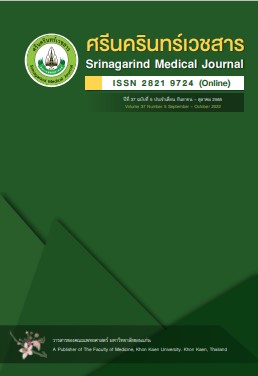แนวทางการดูแลภาวะปากแห้งในผู้สูงอายุ: กรณีศึกษาผู้ป่วย 2 ราย
Guidelines for Management of Oral Dryness (Xerostomia) in the Elderly: A 2 Cases Report
Abstract
หลักการและวัตถุประสงค์: ภาวะปากแห้งในผู้สูงอายุมักเกิดจากหลายปัจจัยรวมกัน การศึกษานี้จึงมีวัตถุประสงค์เพื่อศึกษาวิธีการดูแลภาวะปากแห้งในผู้สูงอายุ ซึ่งได้รับผลกระทบจากโรคประจำตัว รังสีรักษาและการใช้ยา
วิธีการศึกษา: เป็นการศึกษาในผู้ป่วยที่มีภาวะปากแห้ง 2 ราย รายที่ 1 ผู้ป่วยชายไทยอายุ 65 ปี มีอาการปากแห้ง มาตามนัดเพื่อติดตามอาการหลังรับรังสีรักษา 1 เดือน (ธันวาคม 2564) มีโรคประจำตัว เบาหวานชนิดที่ 2 การตรวจภายในช่องปาก ได้รับวินิจฉัยเป็นภาวะปากแห้งรุนแรง ให้การรักษาและติดตามผลการรักษาจนครบ 3 เดือน ผู้ป่วยรายที่ 2 เป็นผู้ป่วยหญิงไทยอายุ 64 ปี ถูกส่งต่อมาเพื่อรักษาและติดตามอาการเนื่องจากตรวจพบภาวะปากแห้งจาก พ.ศ. 2564 ผู้ป่วยมีโรคประจำตัวเป็นความดันโลหิตสูงและเบาหวานชนิดที่ 2 ตรวจภายในช่องปากได้รับการวินิจฉัยเป็นภาวะปากแห้งปานกลาง ให้การรักษาและติดตามผลการรักษาจนครบ 3 เดือน โดยผู้ป่วยทั้ง 2 ราย ใช้เกณฑ์ Clinical oral dryness score (CODS) ในการวินิจฉัย
ผลการศึกษา: พบว่าผู้ป่วยรายที่ 1 หลังให้การรักษาครบ 3 เดือน ผู้ป่วยรู้สึกช่องปากชุ่มชื่นขึ้น แสบในช่องปากน้อยลง กลืนได้ง่ายขึ้น คะแนน CODS ลดลงจากเดิม 7 คะแนนเป็น 5 คะแนน จึงปรับลดยา pilocarpine เป็น 5-10 มิลลิกรัม 1 ครั้งต่อวันร่วมกับวุ้นชุ่มปาก นัดตรวจสุขภาพช่องปากและเคลือบฟลูออไรด์เดือนละ 1 ครั้ง จนครบเดือนที่ 6 หลังการรักษาและติดตามอาการพบว่าผู้ป่วยรู้สึกว่าช่องปากชุ่มชื่นมากขึ้นตรวจภายในช่องปากพบมีน้ำลายเพิ่มขึ้น ไม่มีอาการแสบในช่องปากเลย กลืนได้ง่ายขึ้น และทานอาหารได้มากขึ้น ผู้ป่วยรายที่ 2 หลังให้การรักษาครบ 3 เดือน ผู้ป่วยรู้สึกว่าช่องปากชุ่มชื่นขึ้น ไม่มีอาการแสบในช่องปาก กลืนได้ง่ายขึ้น ตื่นตอนดึกน้อยลง ตรวจในช่องปาก เนื้อเยื่อชุ่มชื่น น้ำลายมีลักษณะค่อนข้างใส คะแนน CODS ลดลงจากเดิม 4 คะแนน เป็น 2 คะแนน เนื่องจากผู้ป่วยมีสภาวะช่องปากที่ดีจึงวางแผนตรวจสุขภาพช่องปากและเคลือบฟลูออไรด์ทุก 6 เดือน
สรุป: ผลจาการใช้แนวทางการรักษาและการดูแลภาวะปากแห้งในผู้สูงอายุทั้ง 2 ราย พบว่ามีอาการดีขึ้น ผู้ป่วยรู้สึกว่าช่องปากชุ่มชื่นขึ้น ไม่มีอาการแสบในช่องปาก กลืนได้ง่ายขึ้น ทานอาหารได้มากขึ้น และคะแนน CODS ลดลง
คำสำคัญ : ผู้สูงอายุ, ภาวะปากแห้ง, การจัดการภาวะปากแห้ง, การรักษาทางรังสีวิทยา
Background and Objective: Oral dryness in the elderly was often found and caused by various combination factors. The purpose of this study was to study how to take care for oral dryness in the elderly patients that affected from chronic disease, radiation therapy, and medication.
Methods: This study performed in 2 cases of patients with oral dryness. Case 1, 65 years-old Thai male patient with oral dryness that came for an appointment for follow-up 1 month after receiving radiotherapy (in December 2021). This case had a congenital disease with Type 2 diabetes and intraoral examination was diagnosed with severe dryness. Provide treatment and follow-up of treatment until 3 months. Case 2, 64year-old Thai woman, was referred for treatment and follow-up due to dry mouth in 2021. The patient had congenital disease with hypertension and type 2 diabetes and Intraoral examination was diagnosed with moderate dryness. Provide treatment and follow-up of treatment until 3 months. Both patients used Clinical oral dryness score (CODS) for diagnosis.
Results: Patient 1, after 3 months of treatment, the patient felt the mouth was moister, less soreness in the mouth, easier to swallow, the CODS score was decreased from 7 to 5, so pilocarpine was reduced to 5-10 mg once a day with oral moisturizing Jelly. Make an appointment for an oral health examination and fluoride coating once a month until the 6th month after treatment and follow-up. It was found that the patient felt that mouth was moister. In the oral examination, there was an increase in saliva. There is no burning sensation in the mouth at all, easier to swallow, and eat more. Patient 2, after 3 months of treatment, the patient felt that the mouth was moister, no burning sensation in the mouth, easier to swallowed, wake up less late at night. The oral examination found moist tissue, saliva was relatively clear, the CODS score decreased from 4 to 2 points. Due to the patient's had good oral condition, the oral examination was planned and fluoride coating every 6 months.
Conclusion: The results of the treatment and care guidelines for dry mouth treatment in both elderly patients showed that patients were improvement in symptoms. The patient felt that the mouth was moister, no burning sensation in the mouth, easier to swallowed, eat more, and decreased CODS scores.
Key world: Elderly, Dry mouth, Management of dry mouth, Radio therapy


